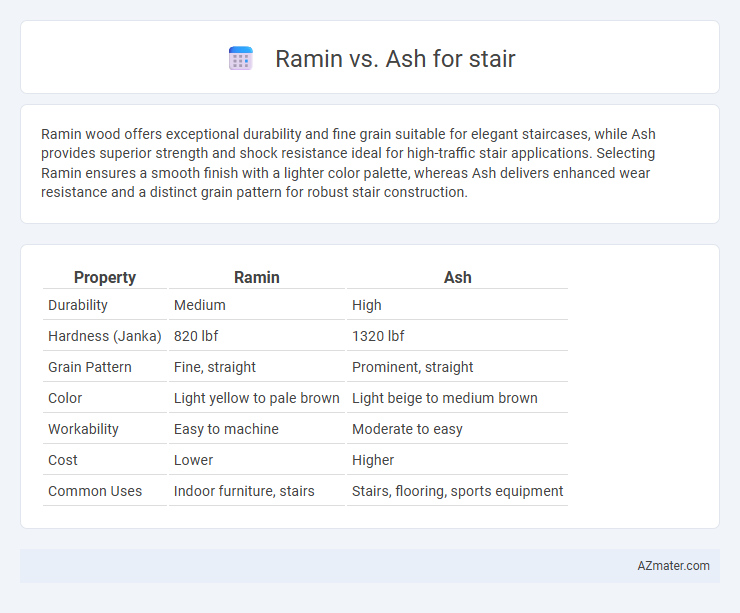Ramin wood offers exceptional durability and fine grain suitable for elegant staircases, while Ash provides superior strength and shock resistance ideal for high-traffic stair applications. Selecting Ramin ensures a smooth finish with a lighter color palette, whereas Ash delivers enhanced wear resistance and a distinct grain pattern for robust stair construction.
Table of Comparison
| Property | Ramin | Ash |
|---|---|---|
| Durability | Medium | High |
| Hardness (Janka) | 820 lbf | 1320 lbf |
| Grain Pattern | Fine, straight | Prominent, straight |
| Color | Light yellow to pale brown | Light beige to medium brown |
| Workability | Easy to machine | Moderate to easy |
| Cost | Lower | Higher |
| Common Uses | Indoor furniture, stairs | Stairs, flooring, sports equipment |
Introduction: Ramin vs Ash for Stair Construction
Ramin wood and Ash are popular choices for stair construction due to their distinct properties. Ramin offers a fine, uniform texture and light color, making it ideal for aesthetic appeal and detailed work. Ash provides exceptional strength and durability with prominent grain patterns, ensuring sturdy and long-lasting stair components.
Wood Characteristics: Ramin vs Ash
Ramin wood is lightweight with a straight grain and pale yellow color, making it ideal for detailed carving and smooth finishes on stair components. Ash wood is denser and tougher, exhibiting a pronounced grain pattern and a light tan color, which enhances durability and provides excellent shock resistance for stair treads and handrails. Choosing between Ramin and Ash depends on the desired balance of weight, strength, and aesthetic appeal in stair construction.
Durability and Strength Comparison
Ramin wood offers moderate durability and strength, making it suitable for indoor stairs but less resistant to heavy wear and moisture compared to Ash. Ash wood is known for its superior strength, hardness, and excellent shock resistance, providing better longevity and structural support for stairs exposed to frequent use. The higher density and resilience of Ash make it a preferred choice for staircases requiring enhanced durability and stability.
Grain and Aesthetic Differences
Ramin wood features a fine, uniform grain with a light yellow to reddish-brown color, offering a smooth and consistent aesthetic ideal for modern stair designs. Ash wood displays a more pronounced, straight grain with a natural pale beige to light brown tone, providing a rustic and textured appearance that enhances traditional staircases. The grain patterns in ash tend to be more dynamic and visually striking compared to the subtle, even grain of ramin, making each choice impactful on the overall stair visual appeal.
Cost Analysis: Ramin vs Ash
Ramin wood offers a lower-cost option for stair construction compared to Ash, with prices typically ranging between $3 to $5 per board foot, whereas Ash can cost between $6 to $9 per board foot due to its higher density and durability. The maintenance costs for Ramin are generally higher as it is less resistant to wear and tear, leading to potential refinishing or repairs over time, while Ash's hardness reduces long-term upkeep expenses. Choosing Ramin may lower initial investment but Ash provides better cost efficiency across the stair's lifecycle due to its superior strength and longevity.
Workability and Installation
Ramin wood offers excellent workability due to its fine, uniform texture and moderate hardness, making it easy to machine, sand, and finish for stair applications. Ash is known for its superior strength and flexibility, which provides durable and shock-resistant stair components but may require more effort during cutting and shaping. Both woods allow for precise installation, with Ramin being favored for intricate detailing, while Ash supports robust structural elements in stair construction.
Resistance to Wear and Damage
Ramin wood exhibits moderate resistance to wear but is more susceptible to scratches and dents compared to Ash, which boasts high durability and exceptional resistance to abrasion, making it ideal for high-traffic staircases. Ash's dense grain structure enhances its ability to withstand daily impact and heavy foot traffic without significant damage or deformation. This superior toughness ensures longer-lasting stair surfaces in both residential and commercial settings.
Environmental Impact and Sustainability
Ramin wood, sourced from Southeast Asia, is prized for its fine texture and workability but faces significant environmental concerns due to overharvesting and habitat loss, making its sustainability questionable. Ash wood, primarily harvested from North American forests, benefits from sustainable forestry practices and faster growth cycles, reducing its overall environmental footprint. Choosing ash promotes lower carbon emissions and better forest management, aligning with eco-friendly and sustainable building initiatives.
Maintenance Requirements for Each Wood
Ramin wood requires minimal maintenance due to its high resistance to wear, decay, and insect damage, making it suitable for high-traffic stairs with occasional cleaning and sealing. Ash wood demands more frequent upkeep, including regular sanding and sealing, to maintain its durability and appearance because it is more susceptible to scratches and moisture. Choosing Ramin over Ash for stairs reduces long-term maintenance efforts, especially in environments prone to humidity or heavy use.
Conclusion: Choosing the Best Wood for Stairs
Selecting the best wood for stairs depends on durability, aesthetic appeal, and budget. Ramin offers a softer texture and lighter color, suitable for decorative stairs with moderate traffic, while Ash provides greater hardness and resilience, ideal for high-traffic areas requiring long-lasting strength. Prioritizing Ash ensures enhanced safety and longevity, whereas Ramin suits projects where cost-effectiveness and visual warmth are desired.

Infographic: Ramin vs Ash for Stair
 azmater.com
azmater.com